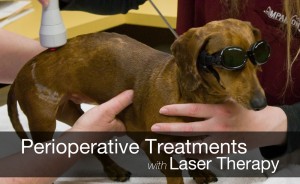“Using Laser Therapy to Maximize Perioperative Treatments”
 Any surgical or dental procedure will cause acute inflammation, a need for tissue repair, and a certain level of post-procedural pain or discomfort. For this reason, patients scheduled for a surgical or dental procedure should be considered for perioperative laser therapy treatments in order to set up these tissues for success, potentiate tissue healing, and minimize post – procedural pain.
Any surgical or dental procedure will cause acute inflammation, a need for tissue repair, and a certain level of post-procedural pain or discomfort. For this reason, patients scheduled for a surgical or dental procedure should be considered for perioperative laser therapy treatments in order to set up these tissues for success, potentiate tissue healing, and minimize post – procedural pain.
The dental patient will benefit from a treatment applied to any extraction site or gingivectomy sites. Gingivitis and stomatitis should also be treated while the patient is under anesthesia. Selecting the “wound treatment” protocol of appropriate surface area is optimal when dealing with extraction sites or gingival resections. The ginigivitis/stomatitis protocol may also be used if the operator desires to treat the entire mouth and should be carried out in both “open mouth” and “closed mouth”protocols to ensure that all tissues including the oral mucosa are adequately illuminated. These treatments will need to be done off-contact, except for the extra oral treatment with “closed mouth” protocol, the latter is best applied with a contact technique. These treatments are easily carried out as the patient will be anesthetized. It is important to remember that we are working near the eyes, so they should be protected, as well as to place a clean / dry towel under the patient’s head to prevent reflection of the laser light from a metallic dental table.
The surgical patient should be treated prior to, possibly during, and post-operatively. For example, a neuter or spay will benefit from treating the site of primary incision (the “wound treatment” protocol of appropriate surface area is sufficient for this) several hours before the procedure and immediately after surgery. Use a contact technique pre-op & non-contact post-op. Performing a preoperative treatment hours prior to the procedure will enable the vasodilation caused by photobiomodulation to subside by the time primary incision is being made, while the neural blockade will remain present at the time of surgery. The same can be applied to an open wound or laceration repair but a contact technique may not be possible due to internal tissues being exposed.
A patient scheduled for a more invasive procedure, such as an extracapsular repair, should also be treated prior to the procedure and immediately post – op, but since we are dealing with deep tissues here, the “pain/trauma” protocol would be more appropriate. A contact technique is also recommended here, with the exception of directly over the incision – it is best to treat incisions non-contact.
An intraoperative treatment should also be done on internal sites while they are still visible prior to the surgeon closing the body wall. Examples include an enterotomy, gastrotomy, cystotomy, or anastomosis. Selecting the “wound treatment” protocol of appropriate surface area is adequate for these sites. A non-contact technique is required here.
It is imperative to maintain a constant scanning technique while treating any of these in order to fully illuminate the target tissues and nearby healthy tissue margins. Several inches of “healthy margin” around the incision should always be treated and the laser therapist should never “hover” directly over the incision line itself. Tissue adhesive and suture material will not be negatively affected as long as this scanning technique is applied during treatment. Metal skin staples will only reflect a small amount of the laser light. The patient and all personnel in the surgical / dental suite, or treatment room need to be wearing the appropriate laser-safe eyewear while any laser therapy treatment is being carried out.
Performing these treatments will not only set up the tissues for success, but potentiate active tissue healing, and provide immediate additional pain relief post-operatively as well.
To learn more about how laser therapy works, click here.




My dog needs laser treatment for gingivitis, so it’s good to know more about what this procedure will be like for him. It’s a relief to know that he’ll probably be under anesthesia during laser treatment. I’m also worried about having laser tools near his eyes, so it’s comforting that you mentioned that they’ll be protected until this treatment is over. Thanks for posting this!
Thank you for your comment! We are glad to have relieved you of some fears about the laser and it’s treatments. As with any patient being considered, your veterinarian will diagnose and design a treatment for your dog’s needs. The laser is a non-invasive, painless tool which is very effective for conditions where there is pain and inflammation.